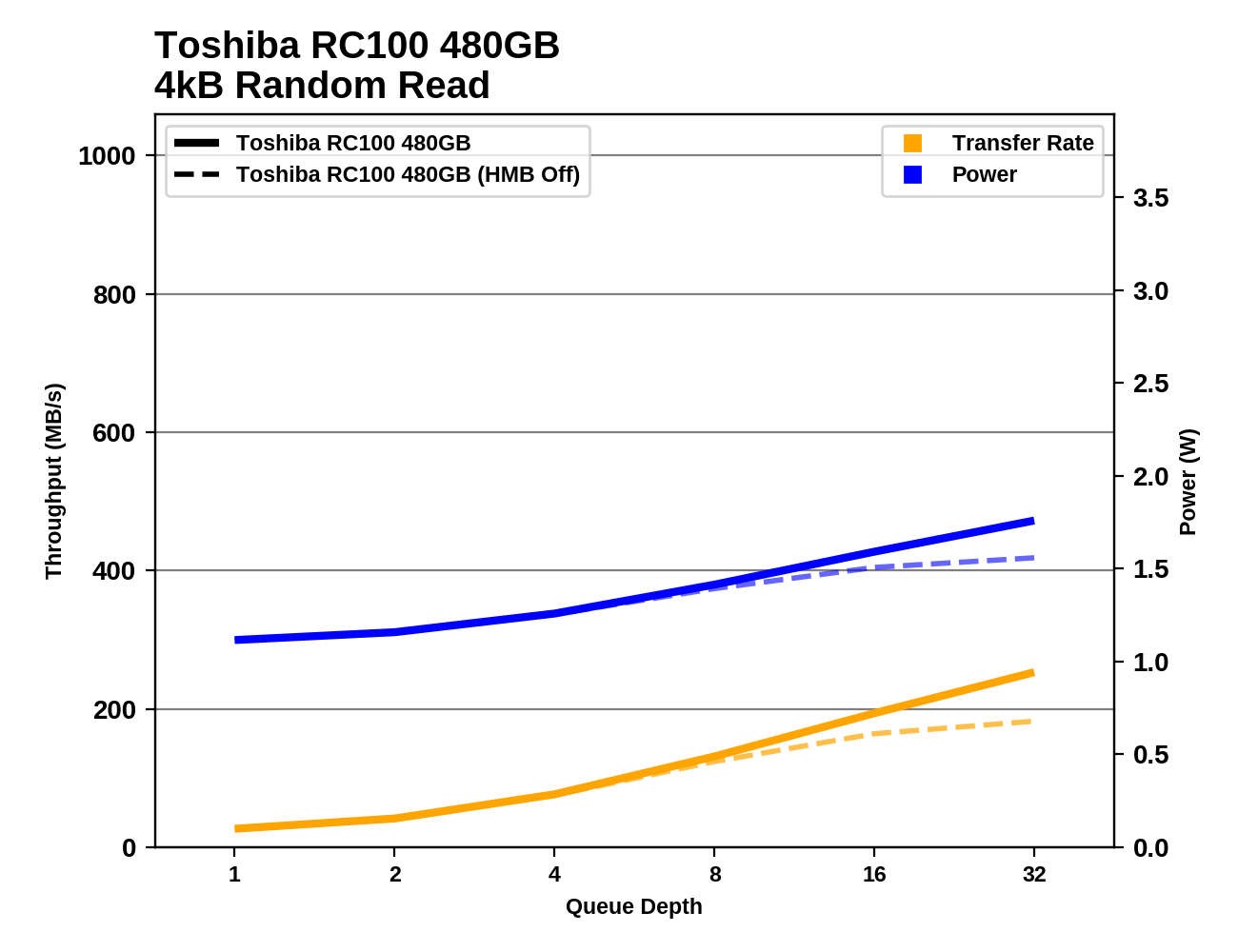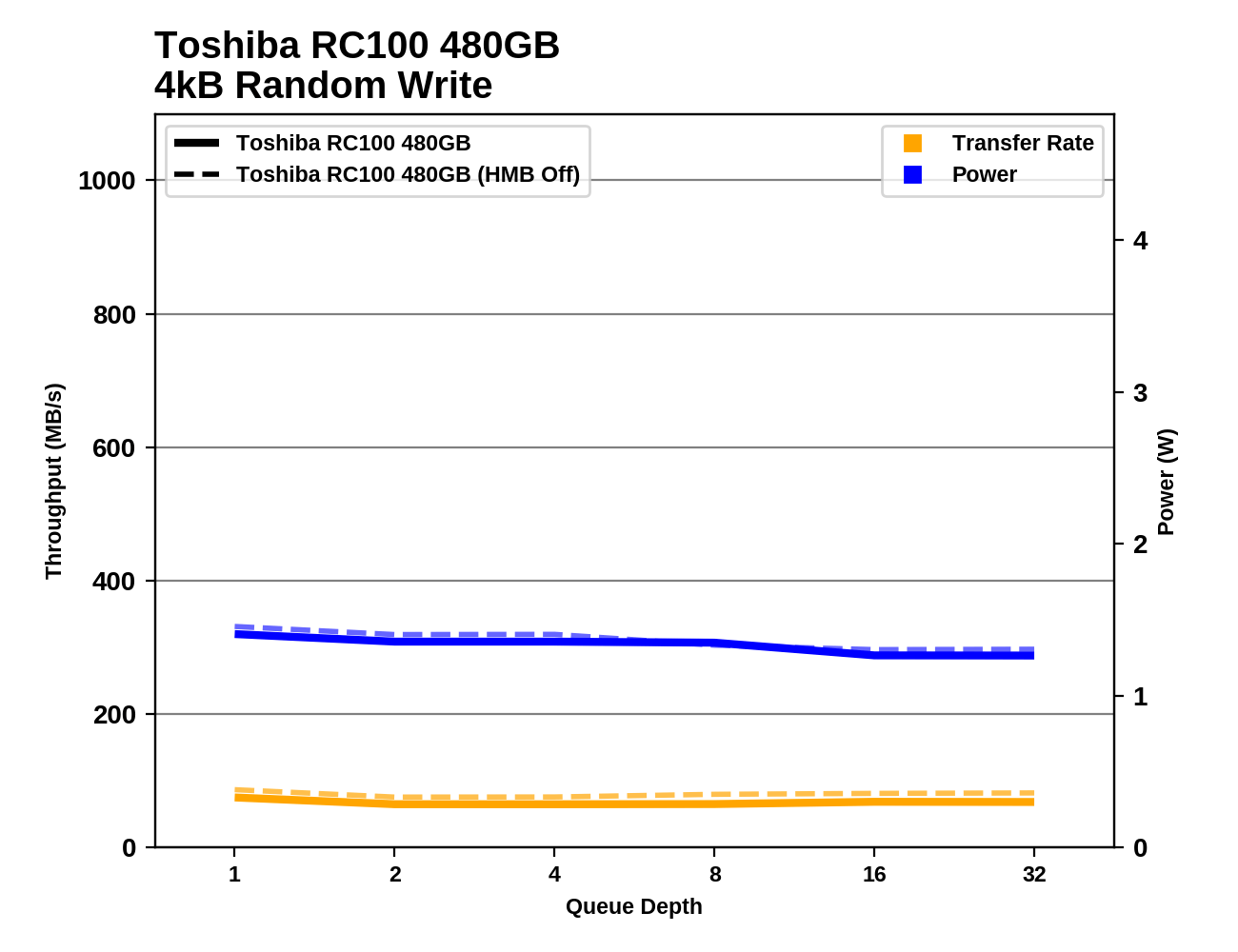The Toshiba RC100 SSD Review: Tiny Drive In A Big Market
by Billy Tallis on June 14, 2018 9:00 AM ESTRandom Read Performance
Our first test of random read performance uses very short bursts of operations issued one at a time with no queuing. The drives are given enough idle time between bursts to yield an overall duty cycle of 20%, so thermal throttling is impossible. Each burst consists of a total of 32MB of 4kB random reads, from a 16GB span of the disk. The total data read is 1GB.

The Toshiba RC100 surprises with excellent burst random read performance, and even when HMB is off it outperforms the other low-end NVMe SSDs we've tested.
Our sustained random read performance is similar to the random read test from our 2015 test suite: queue depths from 1 to 32 are tested, and the average performance and power efficiency across QD1, QD2 and QD4 are reported as the primary scores. Each queue depth is tested for one minute or 32GB of data transferred, whichever is shorter. After each queue depth is tested, the drive is given up to one minute to cool off so that the higher queue depths are unlikely to be affected by accumulated heat build-up. The individual read operations are again 4kB, and cover a 64GB span of the drive.

On the longer random read test that covers a broader span of the drive than HMB can help with, the Toshiba RC100's scores are unsurprisingly in last place among NVMe drives, but it's not too far behind the Intel 600p.
 |
|||||||||
| Power Efficiency in MB/s/W | Average Power in W | ||||||||
The RC100 clearly uses less power during random reads than any other NVMe SSD we've tested, but the poor performance when reading from a wide span of the drive means the efficiency is just a bit below average.
 |
|||||||||
For the larger RC100, the HMB feature has a fairly large impact on random read performance at high queue depths even though the HMB cache is too small to completely handle this workload. At low queue depths and for the smaller 240GB model at any queue depth, HMB has minimal impact on random read performance.
Random Write Performance
Our test of random write burst performance is structured similarly to the random read burst test, but each burst is only 4MB and the total test length is 128MB. The 4kB random write operations are distributed over a 16GB span of the drive, and the operations are issued one at a time with no queuing.

With HMB enabled, the burst random write performance of the Toshiba RC100 is decent, but without HMB it can't beat a mainstream SATA drive.
As with the sustained random read test, our sustained 4kB random write test runs for up to one minute or 32GB per queue depth, covering a 64GB span of the drive and giving the drive up to 1 minute of idle time between queue depths to allow for write caches to be flushed and for the drive to cool down.

Once again, the large working set size of this test compared to the small host buffer size used by the RC100 condemns the drive to last place. The margin between the RC100 and the next-slowest NVMe drive is much larger than it was for the sustained random read test. HMB actually slightly hurts performance here.
 |
|||||||||
| Power Efficiency in MB/s/W | Average Power in W | ||||||||
Power consumption is slightly higher for random writes than for random reads, but still well below the other NVMe SSDs. The performance is low enough that the power efficiency score for the RC100 is worse than all the competition.
 |
|||||||||
Random write performance from the RC100 is low at any queue depth. The drive doesn't have enough memory to perform effective write combining and caching under this sustained load, while high-end drives usually manage to significantly improve performance when working with a large queue of write operations.










62 Comments
View All Comments
Mikewind Dale - Thursday, June 14, 2018 - link
Interesting review. Thanks.I'm hoping that smaller, 11" and 13" laptops will start offering M.2 2242 instead of eMMC. I've been wary of purchasing a smaller laptop because I'm afraid that if the NAND ever reaches its lifespan, the laptop will be dead, with no way to replace the storage. An M.2 2242 would solve that problem.
PeachNCream - Thursday, June 14, 2018 - link
Boot options in the BIOS may allow you to select USB or SD as an option in the event that a modern eMMC system suffers from a soldered on drive failure. In that case, it's still possible to boot from an OS and use the computer. In that case, I'd go for some sort of lightweight Linux OS for performance reasons, but even a full distro works okay on USB 3.0 and up. SD is a slower option, but you may not want your OS drive to protrude from the side of the computer. Admittedly, that's a sort of cumbersome solution to keeping a low-budget PC alive when replacement costs aren't usually that high.peevee - Thursday, June 14, 2018 - link
"but this is only on platforms with properly working PCIe power management, which doesn't include most desktops"Billy, could you please elaborate on this?
artifex - Thursday, June 14, 2018 - link
Yeah, I'd also like to hear more about this.Billy Tallis - Thursday, June 14, 2018 - link
I've never encountered a desktop motherboard that had PCIe ASPM on by default, so at most it's a feature for power users and OEMs that actually care about power management. I've seen numerous motherboards that didn't even have the option of enabling PCIe ASPM, but the trend from more recent products seems to be toward exposing the necessary controls. Among boards that do let you fully enable ASPM, it's still possible for using it to expose bugs with peripherals that breaks things—sometimes the peripheral in question is a SSD. The only way I'm able to get low-power idle measurements out of PCIe SSDs on the current testbed is to tell Linux to ignore what the motherboard firmware says and force PCIe ASPM on, but this doesn't work for everything. Without some pretty sensitive power measurement equipment, it's almost impossible for an ordinary desktop user to know if their PCIe SSD is actually achieving the <10mW idle power that most drives advertise.peevee - Thursday, June 14, 2018 - link
So by "properly working" you mean "on by default in BIOS"? Or there are actual implementation bugs in some Intel or AMD CPUs or chipsets?Billy Tallis - Thursday, June 14, 2018 - link
Implementation bugs seem to be primarily a problem with peripheral devices (including peripherals integrated on the motherboard), which is why motherboard manufacturers are often justified in having ASPM off by default or entirely unavailable.AdditionalPylons - Thursday, June 14, 2018 - link
That's very interesting. And thanks Billy for a nice review! I too appreciate you doing something different. There will unfortunately always be someone angry on the Internet.Kwarkon - Friday, June 15, 2018 - link
L1.2 is a special PCIe link state that requires hardware CLREQ signal. When L1.2 is active all communication on PCIe is down thus both host and NVME device do not have to listen for data.Desktops don't have this signal ( it is grounded), so even if you tell the SSD (NVME admin commands) that L1.2 support is enabled it will still not be able to negotiate it.
In most cases m.2 NVME require certain PCIe link state to get lowest power for their Power State.
The PS x are just states that if all conditions are met than the SSD will get its power down to somewhere around stated value.
You can always check tech specs of the NVME. If in fact low power is supported than the lowest power will be stated as "deep sleep L1.2 " or similar.
Death666Angel - Saturday, June 16, 2018 - link
Prices in Germany do not line up one bit with the last chart. :D The HP EX920 1TB is 335€ and the ADATA SX8200 960GB is 290€. The SBX just has a weird amazon.de reseller who sells the 512GB version for 200€. The 970 Evo 1TB is 330€ and the Intel 760p 1TB is 352€. And for completeness, the WD Black 1TB is 365€. Even when accounting for exchange rates and VAT, the relative prices are nowhere near the US ones. :)